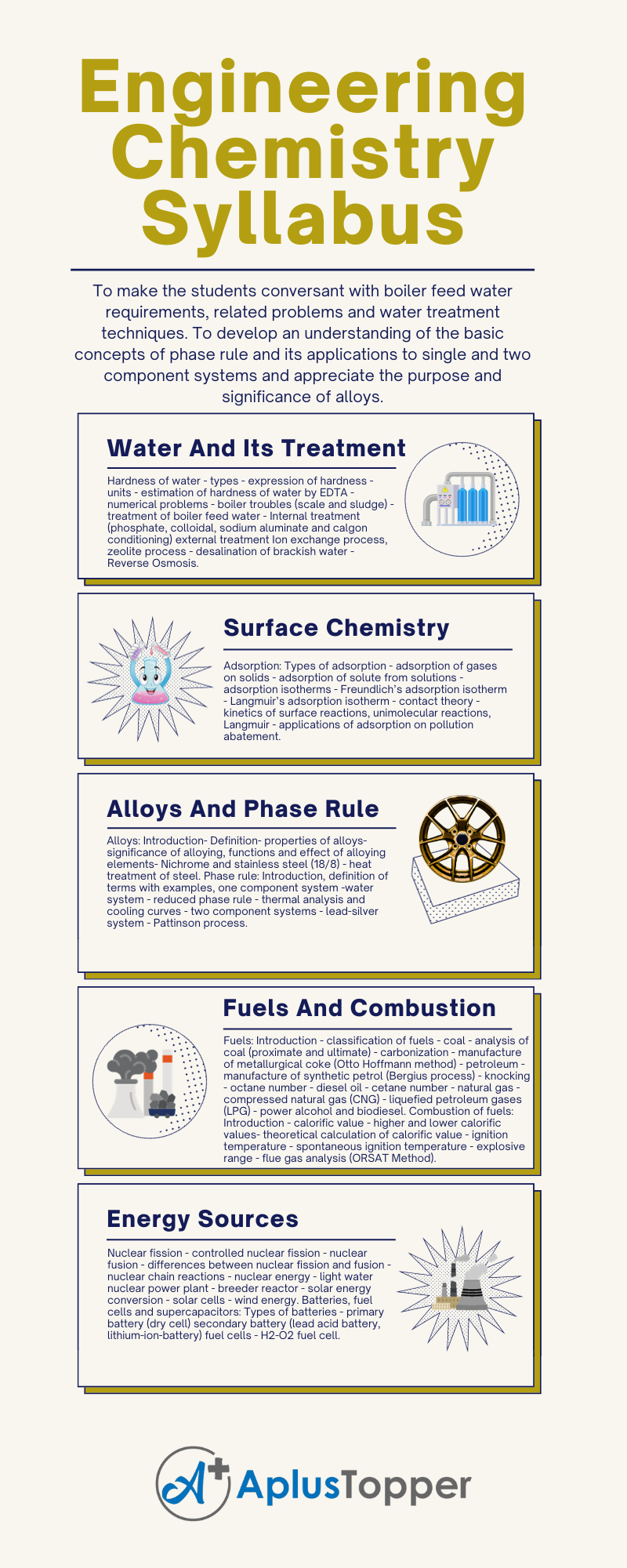Code – CY8151, this article about B.E/B.Tech./B.Arch Mechanical Engineering Semester I Engineering Chemistry syllabus. Students are requested to make notes or PDFs of the semester in Engineering Chemistry for effective preparation from here. It will help you to understand what are the topics in the syllabus.
And to make preparation strategies to score well in the examinations. Unit-wise detailed syllabus is given below in one place, in the following article CY8151 – Engineering Chemistry Syllabus. If the information helps you, kindly share it with your classmates.
If you want to know more about the syllabus of B.E Mechanical Engineering connected to an affiliated institution’s four-year undergraduate degree programme. We provide you with a detailed Year-wise, semester-wise, and Subject-wise syllabus in the following link B.E Mechanical Engineering Syllabus Anna University Regulation 2017.
Aim Of Concept:
- To make the students conversant with boiler feed water requirements, related problems and water treatment techniques.
- To develop an understanding of the basic concepts of phase rule and its applications to single and two component systems and appreciate the purpose and significance of alloys.
- Preparation, properties and applications of engineering materials.
- Types of fuels, calorific value calculations, manufacture of solid, liquid and gaseous fuels. Principles and generation of energy in batteries, nuclear reactors, solar cells, wind mills and fuel cells.
CY8151 – Engineering Chemistry Syllabus
Unit I: Water And Its Treatment
Hardness of water – types – expression of hardness – units – estimation of hardness of water by EDTA – numerical problems – boiler troubles (scale and sludge) – treatment of boiler feed water – Internal treatment (phosphate, colloidal, sodium aluminate and calgon conditioning) external treatment Ion exchange process, zeolite process – desalination of brackish water – Reverse Osmosis.
Unit II: Surface Chemistry And Catalysis
Adsorption: Types of adsorption – adsorption of gases on solids – adsorption of solute from solutions – adsorption isotherms – Freundlich’s adsorption isotherm – Langmuir’s adsorption isotherm – contact theory – kinetics of surface reactions, unimolecular reactions, Langmuir – applications of adsorption on pollution abatement.
Catalysis: Catalyst – types of catalysis – criteria – autocatalysis – catalytic poisoning and catalytic promoters – acid base catalysis – applications (catalytic convertor) – enzyme catalysis- Michaelis – Menten equation.
Unit III: Alloys And Phase Rule
Alloys: Introduction- Definition- properties of alloys- significance of alloying, functions and effect of alloying elements- Nichrome and stainless steel (18/8) – heat treatment of steel. Phase rule: Introduction, definition of terms with examples, one component system -water system – reduced phase rule – thermal analysis and cooling curves – two component systems – lead-silver system – Pattinson process.

Unit IV: Fuels And Combustion
Fuels: Introduction – classification of fuels – coal – analysis of coal (proximate and ultimate) – carbonization – manufacture of metallurgical coke (Otto Hoffmann method) – petroleum – manufacture of synthetic petrol (Bergius process) – knocking – octane number – diesel oil – cetane number – natural gas – compressed natural gas (CNG) – liquefied petroleum gases (LPG) – power alcohol and biodiesel. Combustion of fuels: Introduction – calorific value – higher and lower calorific values- theoretical calculation of calorific value – ignition temperature – spontaneous ignition temperature – explosive range – flue gas analysis (ORSAT Method).
Unit V: Energy Sources And Storage Devices
Nuclear fission – controlled nuclear fission – nuclear fusion – differences between nuclear fission and fusion – nuclear chain reactions – nuclear energy – light water nuclear power plant – breeder reactor – solar energy conversion – solar cells – wind energy. Batteries, fuel cells and supercapacitors: Types of batteries – primary battery (dry cell) secondary battery (lead acid battery, lithium-ion-battery) fuel cells – H2-O2 fuel cell.
Text Books:
- S. S. Dara and S. S. Umare, “A Textbook of Engineering Chemistry”, S. Chand & Company LTD, New Delhi, 2015.
- P. C. Jain and Monika Jain, “Engineering Chemistry” Dhanpat Rai Publishing Company (P) LTD, New Delhi, 2015.
- S. Vairam, P. Kalyani and Suba Ramesh, “Engineering Chemistry”, Wiley India PVT, LTD, New Delhi, 2013.
References:
- Friedrich Emich, “Engineering Chemistry”, Scientific International PVT, LTD, New Delhi, 2014.
- Prasanta Rath, “Engineering Chemistry”, Cengage Learning India PVT, LTD, Delhi, 2015.
- Shikha Agarwal, “Engineering Chemistry-Fundamentals and Applications”, Cambridge University Press, Delhi, 2015.
If you want to check the syllabus of other branches provided by Anna University, Anna University syllabus Regulation 2017 will assist you in a clear path. Hope you find the required details.
Related Posts Of Semester – I:
- HS8151 – Communicative English Syllabus.
- MA8151 – Engineering Mathematics -1 Syllabus.
- PH8151 – Engineering Physics Syllabus.
- GE8151 – Problem-Solving and Python Programming Syllabus.
- GE8152 – Engineering Graphics Syllabus.
- GE8161 – Problem Solving and Python Programming Laboratory syllabus.
- BS8161 – Physics and Chemistry Laboratory Syllabus.
